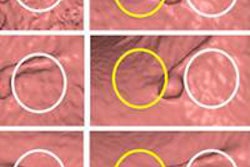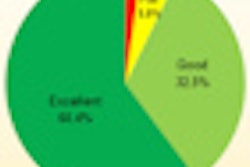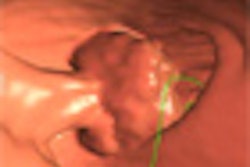The benefits of colon cancer screening with virtual colonoscopy far outweigh the risk of radiation-induced cancers, even when the exam is repeated every five years between the ages of 50 and 80, concludes a new study in the April issue of the American Journal of Roentgenology.
The notion that the radiation dose from virtual colonoscopy (also known as CT colonography or CTC) scans could be harmful over decades of screening is central not only to concerns about patient safety, but also to the viability of the technique as an attractive and potentially safer alternative to optical colonoscopy. Indeed, the U.S. Preventive Services Task Force (USPSTF) cited uncertainty over safety of the radiation dose of repeated VC exams in its 2009 recommendation against screening CTC as a Medicare-covered exam.
In the new study, researchers built a risk model to estimate the ratio of cancers prevented to cancers induced for CTC screening every five years between the ages of 50 and 80. The study authors included Amy Berrington de González, PhD, from the U.S. National Cancer Institute, and colleagues from nine other institutions worldwide including Kyung Hee University in Yongin, South Korea; Massachusetts General Hospital in Boston; Erasmus University Medical Center in Rotterdam; and the University of California, San Francisco (AJR, April 2011, Vol. 196:4, pp. 816-823).
Basing their work on the Biological Effects of Ionizing Radiation (BEIR) VII committee of the National Research Council, the group estimated the potential reduction in colorectal cancer incidence from CTC screening using three different models simulating colorectal cancer prevalence, and then calculated the benefit-risk ratio according to patient age at initial screening, the authors wrote.
Doses were estimated based on prone and supine imaging from a single CTC exam at ages 40, 50, 60, and 70 years, as well as every five years from age 50 to 80 as recommended by screening organizations. The modeled exam protocol was the one used in the National CT Colonography Trial (ACRIN 6664) (New England Journal of Medicine, September 18, 2008, Vol. 359:12, pp. 1207-1217).
Imaging parameters included tube voltage of 120 kVp, 1.0- to 1.25-mm slice collimation, and tube current of 50 mAs for a medium-sized patient, and the data were used by computer software to estimate organ doses. Individuals with positive VC results were assumed to undergo subsequent screening or surveillance with optical colonoscopy, and undergoing each subsequent test depended on the probability of surviving an additional five years.
The BEIR VII-based models were based on cancer incidence data from the latest follow- up of Japanese atomic bomb survivors. For thyroid and breast cancer, however, data from medically exposed populations were used instead.
Uncertainty intervals were estimated using Monte Carlo simulation methods, enabling the quantification of radiation risk estimates. Comparative modeling with three colorectal cancer models (MISCAN, SimCRC, and CRC-Spin) was used to estimate the potential reduction in colorectal cancer cases.
The three colon cancer models were previously used to estimate the cost-effectiveness of CTC screening for colorectal cancer in the Medicare population in advance of the 2009 Medicare coverage decision. The authors estimated the mean effective dose per CTC screening study at 8 mSv for men and 7 mSv for women.
Mortality
The group found that performing CTC screening every five years from age 50 to 80 would lead to 150 cases of radiation-related cancer in the hypothetical population of 100,000 individuals (95% uncertainty interval: 80-280).
The cancer risk from CTC exams varied by age: It stood at 2.5 to seven cancers after a single screening at age 50, but moved to one to four cancers per 100,000 individuals after a screening at age 70. Overall, 15 to 35 cancers per 100,000 could be estimated after screening from age 50 to 80.
The risk was much higher for the 50 to 64 age group than the 65 to 80 age group, the researchers noted. The benefit-risk ratio was lowest for scanning ages 40 to 49, at 1.5:1 with a lower uncertainty limit of 0.8:1.
Meanwhile, the number of lives saved from CTC screening for colorectal cancer ranged from 3,180 to 5,190 per 100,000 across the three screening models, resulting in a benefit-risk ratio that ranged from 24:1 (95% uncertainty interval: 13:1-45:1) to 35:1 (95% uncertainty interval: 19:1-65:1), based on the cancer prevalence model used.
The benefit-risk ratio was much larger for screening ages 65 to 80 compared to ages 50 to 64, but the ratios were greater than 1:1 across all three simulation models, the authors noted.
"The benefits from screening every five years from the age of 50 to 80 were estimated to clearly outweigh the radiation-related cancer risks," the authors wrote. "Inclusion of the radiation-related risk from CT examinations performed to follow up extracolonic findings did not materially alter these findings."
Screening every 10 years instead of five would cut the cancer risk approximately in half, they noted.
Use of the ACRIN 6664 protocol ensured that the resulting risk assessments would be directly comparable to those encountered in the clinical setting, particularly because the trial included a wide variety of scanners ranging from 16 to 64 detector rows.
A previous study by Brenner and Georgsson estimated the risk of radiation-related cancer from a single CTC screening as more than twice as high as the estimate in the present study. However, this difference relates mainly to different assumptions regarding risk in the BEIR VII report compared to the BEIR V report, on which the earlier study was based.
Several studies have shown that 5% to 10% of CTC exams result in extracolonic findings. Only crude estimates were used to calculate the risk in the present study owing to sparse data in the literature.
"An important strength of our study is the use of Monte Carlo simulation methods to quantify the uncertainties in the radiation risk estimates; this strategy allowed us to examine the benefit-risk ratio at the extremes of the radiation risk limits," they wrote.
Still, many uncertainties remain, such as the effectiveness of low-level x-rays in cancer induction.
"Concerns have been raised about recommending CTC as a routine screening tool because of potential harms including the radiation risks," the authors wrote. "Based on these models, the benefits from CTC screening every five years from the age of 50 to 80 years clearly outweigh the radiation risks."



















